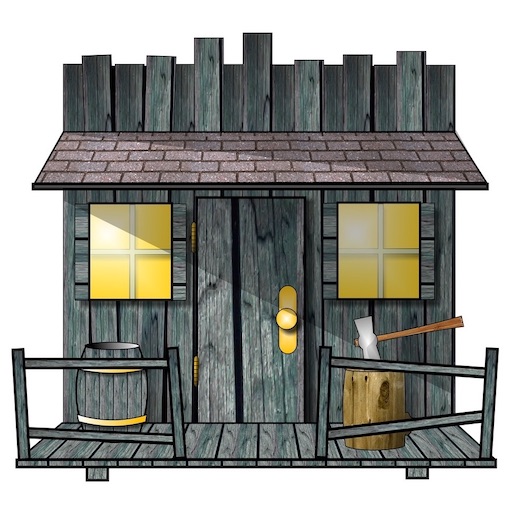Officially the 250th Infantry Division of the Wehrmacht and comprising Spanish Volunteers, this unit was also know as the Spanish Volunteer Division, Division Azul, or the Blue Division.
The men of the Division were known as “Guiripas” or “Guripas”, which I understand means little devils or soldiers in Spanish, like Grunt, GI, or Tommy in English.
Orbat 1941
When in 1941 the Division left Grafenwohr for Russia, the Order of Battle was as follows:
| Deutsch | Español | English | Number of Men | Commander | Comment |
|---|---|---|---|---|---|
| Estado Mayor Divisional | Divisional General Staff | 189 | Lt. Gen. Antonia Munoz Grandes | ||
| Infanterie-Regiment 262 | 262 Regimiento de Infanteria “Pimental” | 262nd Infantry regiment “Pimental” | 3,012 | Colonel Pimentel Zallas | Recruited mainly in Barcelona. |
| Infanterie-Regiment 263 | 263 Regimiento de Infanteria “Vierna” | 263rd Infantry regiment “Vierna” | 3,012 | Colonel Vierna Trápaga. | Recruited mainly in Valencia. |
| Infanterie-Regiment 269 | 268 Regimiento de Infanteria “Esparza” | 269th Infantry regiment “Esparza” | 3,012 | Colonel Martinez Ezparza. | Recruited mainly in Seville. |
| Feldersatz-Bataillon 250 | 250 Batallón de Reserva (Reserva Móvil “Tía Bernarda”) | 250th Reserve Battalion (Mobile reserve ‘Aunt Bernadine’) | 601 | Commandante Fernando Osés Armesto | |
| Artillerie-Regiment 250 | 250 Regimiento de Artilleria | 250th Artillery regiment | 2,793 | Colonel Badillo Perez. | |
| Grupo de cañones | Artillery group | 531 | |||
| Panzerjäger-Abteilung 250 | 250 Grupos antitanque | 250th Anti-tank group | 574 | Cmte. César Rguez. Galán | |
| Aufklärungs-Abteilung 250 | 250 Grupo de exploración | 250th Reconnaissance Group | ?? | ||
| Ski-Kompanie 250 | 250 Compañía del esquí | 250th Ski company | 206 | Captain Ordás. | |
| Pionier-Bataillon 250 | 250 Zapadores Batallón | 250th Sapper battalion | 712 | ||
| Nachrichten-Abteilung 250 | Grupo de señales | 250th Signals group | 511 | ||
| Sanitäts-Abteilung 250 | Servicio médico | 250th Medical group | 518 | ||
| Servicios administrativos | Administrative Services | 257 | |||
| Servicio de Transportes | Transport Services | 1,034 | |||
| Policía militar | Miliary Police | 33 | |||
| Correos militares | Military Post Office | 18 | |||
| Servicio veterinario | Veterinary Services | 237 | |||
| 17,046 |

Blue Division HQ
Lt. Gen. Antonia Munoz Grandes commanded during the period 20 Jul 41 – 13 Dec 42. He was succeeded by Lt. Gen. Emilo Esteban Infantes 13 Dec 42 – 20 Oct 43. Colonel Rodrigo was the second-in-command.
“Abteilung” translates to “Grupo” in Spanish and either “Battalion” or “Group” in English.
The Divisional order of battle changed relatively little. The ski company was formed at the end of 1941 to combat infiltrations by Soviet Ski troops along the west shore of Lake Ilmen. By September 1943 the Feldersatz Battalion had disappeared and the Infantry Regiments had become Grenadier Regiments. My mate Roland Davis offers some insight in the last change:
At some point Hitler made all infantry units into grenadier units. It was only a change in title and had no other effects that I know of. It was meant as a morale boosting gesture but because it was applied to all infantry units, regardless of quality, I doubt it had any affect.
The members of the Blue Division pronounced the units numbers digit-by-digit, that is, ” two-six-nine” (“dos-seis-nueve”), not “two-hundred-and-sixty-nine” or “…-ninth”. In addition the Infantry Regiments were known by the names of their commanders, “Pimental”, “Vierna” and “Ezparza” respectively.
Infantry Regiments
Each regiment had:

48 degrees below
Blue Division Infantry/Grenadier Regiment
- 3 x infantry battalions (companies 1-12 *), each containing
- 3 x infantry companies **
- 1 x heavy weapons company including
- MG34 machine guns
- 6 x 81mm mortars
- 1 x infantry gun company (13th) containing
- 3 x sections of horse-drawn 7.5 cm guns (2 guns each)
- 1 x section of horse-drawn 15.0 cm guns (2 guns)
- 1 x anti-tank company (14th) containing
- 4 x sections each with
- 3 x towed 3.7 cm anti-tank guns (Pak 36) ***
- 4 x sections each with
- 1 x company (15th) of assault engineers ****
- 1 x assault platoon *****

Blue Division Helmet
* Companies were number sequentially within the regiment. Companies 1-4 were in the first battalion, 5-8 in the second battalion, and 9-12 in the third. Companies 4, 8 and 12 were heavy weapons companies.
The 11th company of each regiment (3rd Infantry company of the 3rd Battalion) was equipped with bicycles.
** The infantry were armed with conventional German weaponry, although captured Soviet 7.62 mm PPSh.41 sub-machine guns were very popular.
*** By 1942 the 5.0 cm Pak 38 was replacing the 3.7 cm Pak 36. There is a good chance the Blue Division retained the Pak 36 until departure.
**** The TO&E I’ve seen list a company of assault engineers (Zapadores de Asaltos) within each Regiment in addition to the Sapper Battalion of 3 companies.
***** Each Regiment had an assault platoon used for special attack and demolition work. I’m not sure if they were an ad hoc organisation (likely) or possibly part of the assault engineers.
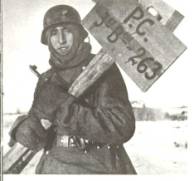
3rd Battalion 263
Reserve Battalion
Made up of three Infantry companies. This was formed from the left over personnel when the original Spanish organisation was abandoned in favour of a German 3 Regiment Division. The Reserve Battalion became the shock force of the division. It is possible that this unit made higher use of the captured Soviet 7.62 mm PPSh.41 sub-machine guns than other units. By September 1943 this unit had disappeared – presumably by casualties and drafts into the rest of the Division.
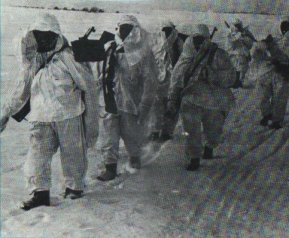
Reconnaisance Group
Reconnaissance group
All the men were from the Spanish Cavalry Corp, which perhaps explains why this unit was organised into squadrons like a cavalry unit.
Originally there were meant to have horses, but apparently they were actually issued bicycles.
.
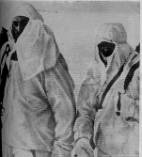
Sky company on patrol
Ski company
The ski company was formed at the end of November 1941 to combat infiltrations by Soviet Ski troops along the western shore of Lake Ilmen (Proctor, 1974; Scurr, 1980). Proctor says Captain Ordás commanded the company, however, Scurr suggests Ords was from the 5th Anti-tank Company and only took command in 10 January 1942. On this date it contained 206 officers and men. Proctor says Lieutenant Otero de Arce took over command after the operation across Lake Ilmen (mid Jan 1942).
Artillery Regiment
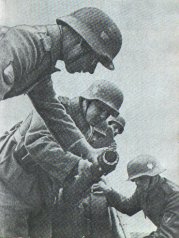
4 groups, all horse drawn.
Artillery Regiment
- 1st Light Group: 3 batteries of 10.5 cm leFH 18 field howitzers
- 2nd Light Group: 3 batteries of 10.5 cm leFH 18 field howitzers
- 3rd Light Group: 3 batteries of 10.5 cm leFH 18 field howitzers
- 4th Heavy Group: 3 batteries of 15.0 cm guns.
Apparently 4 gun Batteries were the standard in German service, so the Spanish units probably had the same composition.
There is an interesting note in Proctor (1974) to the effect that “The Spanish artillery had been implemented by French 155 guns, but they were without transport or tractors (p. 163).
Artillery group
I don’t know anything about the “Grupo de cañones”. German infantry divisions did not have anything like that. Two of my sources mention it, both Spanish, and both obviously have the same ultimate source, as they have identical lists of unit names in the Division and the numbers of men for each unit are also identical. “Cañones” means tubes, and could mean either Artillery or Mortars. I don’t know which makes more sense in this context.
None of which helps me with the purpose or internal organisation. My mate Roland Davis offers a possible explanation:
Each infantry regiment has its own infantry gun battery and the Spanish may have ‘grouped’ them together. This would give about the right number of people and would account for the ad-hoc designation ‘Grupo’ instead of a more formal one like battalion or regiment. It is only a guess but different nations did have different ideas about the use and allocation of infantry guns so it is a possibility.
If this is true then the Artillery Group would contain
- 18 x 7.5 cm guns – probably organised into 4 or 5 Batteries
- 6 x 15.0 cm guns – probably organised into 1 or 2 Batteries
Anti-tank group

Man-handled Antitank gun
“Panzerjäger” means “Tank Hunter” and could mean self-propelled guns, but in this case meant conventional anti-tank guns. The unit had 36 x 3.7 cm anti-tank weapons (Pak 36) in three batteries.
Anti-tank Group
- 3 x Anti-tank Batteries
- 4 x Anti-tank section
- 3 x 3.7 cm anti-tank weapons (Pak 36)
- 4 x Anti-tank section
By 1942 the 5.0 cm Pak 38 was replacing the Pak 36 however the Blue Division probably never received the update. Unlike the artillery which relied on horse transport, the anti-tank group had vehicular transport (although the transport isn’t in evidence in the photo); apparently the vehicles were confiscated in France, and were a mixture of Peugeots, Packards, Hustons, etc.
Military Police
The Military Police were manned by Civil Guard.
